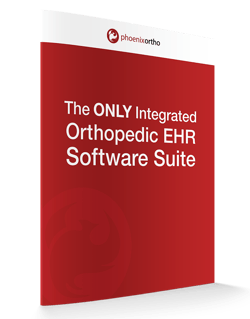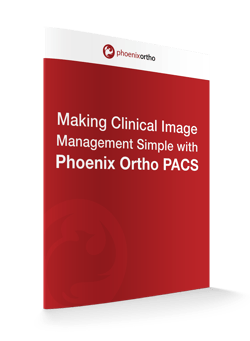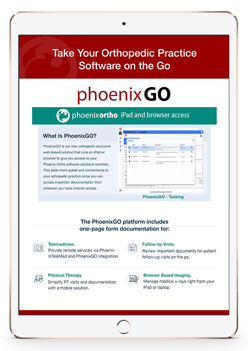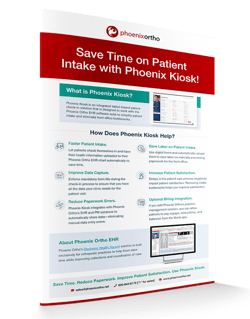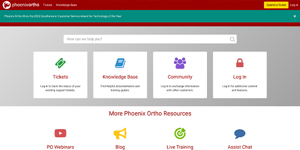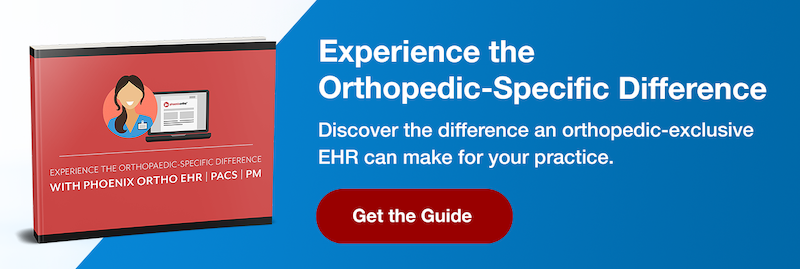The terms electronic health record (EHR) and electronic medical record (EMR) are used almost interchangeably by some medical practitioners for software—and even some software vendors.
However, when comparing EHR vs EMR software, there is a distinct difference between the two despite their broad similarities.
What is the difference between EMR vs EHR software? More importantly, which one is the best fit for your orthopedic clinic?
Let’s discuss what each software is, their major difference(s), and how you can benefit from this software.
What Is EMR Software?
An Electronic Medical Record software is basically a digital patient chart—containing all of the same data that would be on a traditional paper chart. EMRs are primarily meant for the practice’s internal use to help diagnose and treat the patient. They are not generally optimized for sharing information with other providers and may not have any information that you wouldn’t normally find on a paper chart.
What Is EHR Software?
Electronic Health Record software also holds the same data as a traditional paper chart (in fact, they often have a “chart view” that lets physicians look at the patient’s medical chart information). However, EHR software doesn’t stop at just the patient chart.
Instead, an EHR will often have supplementary data such as the patient’s full health history, visit notes, and (in cases where a PACS solution is integrated with the EHR) medical images related to that patient.
These software programs may also be designed to make sharing data with other medical specialists and primary care providers easier for a clinic, capture visit notes to help with setting billing codes, and other functions depending on the EHR vendor.
Benefits of EHR vs EMR Software
So, what are the benefits of using an EHR vs an EMR solution for your orthopedic clinic? As an orthopedic surgeon, you might think that just having an electronic version of the patient chart is enough for your needs.
While simply having an electronic chart can be a big help for improving data capture and preventing miscommunications and errors caused by manually-written charting procedures, the flexibility offered by EHRs can help to further enhance the efficiency of your whole practice.
Some common benefits of using an EHR over a more limited EMR solution include:
Improving Billing Processes
By capturing patient visit notes in the EHR and applying that information to the evaluation & management (E & M) coding process, you can streamline your billing process and reduce claims rejections.
The more information you have when setting the E & M code, the more accurately you can bill the payer organization. This helps you avoid under- or over-billing the patient’s health plan, employer, or other payer organization to maximize collections while minimizing time spent submitting corrections for rejected claims.
Providing a Whole Health History
With an EHR software, all of the patient’s data is at your fingertips, so you can double-check their personal and family health histories with ease. This makes it much easier for you to see the entire picture of someone’s current health status, including any at-risk concerns about which they should know as they’re a patient at your facility.
Integration with Other Software
While not true for all EHR software, some EHRs are part of an integrated suite of software solutions that make collating data from multiple sources in your clinic much easier.
For example, Phoenix Ortho’s EHR is integrated with optional PACS, PM, and patient intake solutions to make collecting patient images and health histories a breeze—and then help with billing the patient at the point of care. This helps you save time and labor so you can reclaim your day!
Streamlining Communication of Patient Information
Orthopedists—particularly physical and occupational therapists—are often consulted as part of a patient’s larger care plan. With an EHR that simplifies the sharing of important patient data (such as visit notes, prescription information, and more), it’s easier for orthopedic surgeons to work with primary care facilities and other specialists.
This, in turn, makes other medical practitioners more willing to partner with the orthopedic specialist—potentially increasing referral business.
Which Type of Medical Record Is Right for Your Orthopedic Business?
So, which type of medical record solution is right for your orthopedic business? If all you really want is a digital version of the patient medical chart, then an EMR software may be able to meet your most basic needs.
However, if you really want to increase efficiency, improve collections, and remove bottlenecks from your medical practice, then an EHR is your best option.
Of course, not all EHRs are created equally. To maximize your time saved, it’s important to use a solution designed exclusively for orthopedic clinics.
Phoenix Ortho’s EHR software suite is the only orthopedic-exclusive EHR solution on the market. With our software, you know that every resource is being dedicated to making the EHR better meet your needs—not the needs of any other specialty or primary care facility’s needs.
We have refined our software using feedback from real orthopedic surgeons to cut out the unnecessary forms and features that make non-orthopedic solutions so clunky and time-consuming to use.
Save time and headaches by making the switch to Phoenix Ortho today!
Schedule a 1:1
Get in touch with Phoenix Ortho to learn more about how you can save time, money, and mouse clicks with an orthopedic-specific EHR.





